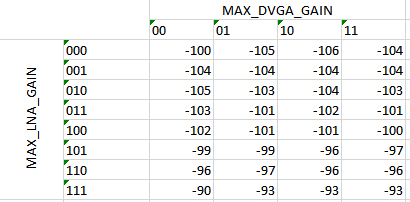Hi, I'm using an Olimex development board with CC430 at 38.4k baud, 915MHz. In the CC430 user guide, it says that I must generate a similar table to the one in 25.3.3.6.4.1 with different MAX_DVGA_GAIN and MAX_LNA_GAIN values. I have been setting the AGCCTRL2 registers with different values and reading off the RSSI values when the radio is in RX mode. I got this table
Compared to the pattern of numbers in the user guide, this table is definitely incorrect. Can I please get a pointer on how to get the CS RSSI value correctly? Thanks.
This is my code for thus far. It runs on 1 device that is just sitting there by itself (without any other devices sending data)
#include <msp430.h>
#include "main.h"
#include "../prj40_core/hal.h"
#include "../prj40_core/phy.h"
#include "../prj40_core/RF1A.h"
#include "../prj40_core/RFPacket.h"
#define BYTETOBINARYPATTERN "%d%d %d%d%d %d%d%d"
#define BYTETOBINARY(byte) \
(byte & 0x80 ? 1 : 0), \
(byte & 0x40 ? 1 : 0), \
(byte & 0x20 ? 1 : 0), \
(byte & 0x10 ? 1 : 0), \
(byte & 0x08 ? 1 : 0), \
(byte & 0x04 ? 1 : 0), \
(byte & 0x02 ? 1 : 0), \
(byte & 0x01 ? 1 : 0)
#define DEVICE_1
#define RSSI_SAMPLES 20
uint8_t RxBuffer[255], RxBufferLength = 0;
int16_t rssiValues[RSSI_SAMPLES];
int16_t rssiAvg = 0;
uint8_t rssiIdx = 0;
uint8_t max_dvga_gain = 0;
uint8_t max_lna_gain = 7;
uint8_t displayedAvg = 0;
uint8_t main(void) {
WDTCTL = (uint16_t)(WDTPW | WDTHOLD); /* Stop watch dog timer */
__disable_interrupt();
//ACLK = REFO 32768 Hz
//MCLK = SMCLK = 12 MHz
//UART 9600
hal_init430();
phy_reset();
phy_enableRX();
TA1CCTL0 = CCIE; // CCR0 interrupt enabled
TA1CCR0 = 8191;
TA1CTL = TASSEL__ACLK + MC__UP + TACLR; // ACLK, upmode, clear TAR
WriteSingleReg(AGCCTRL2, (max_dvga_gain << 6) | (max_lna_gain << 3) | 0x03);
__enable_interrupt();
while(1);
}
/* Application specific isr */
#pragma vector=TIMER1_A0_VECTOR
__interrupt void TIMER1_A0_ISR(void)
{
if(rssiIdx != RSSI_SAMPLES) {
printf("%c", '.');
rssiValues[rssiIdx] = phy_getRSSI();
rssiIdx++;
} else {
/* done */
uint8_t i;
for(i = 0; i < RSSI_SAMPLES; i++) {
rssiAvg += rssiValues[i];
}
rssiAvg = rssiAvg/RSSI_SAMPLES; /* RSSI_SAMPLES samples */
if(!displayedAvg) {
P1OUT |= BIT0;
displayedAvg = 1;
printf("\r\n");
printf("MAX_DVGA_GAIN = %d\r\n", max_dvga_gain);
printf("MAX_LNA_GAIN = %d\r\n", max_lna_gain);
printf("AGCCTRL2 = "BYTETOBINARYPATTERN, BYTETOBINARY(ReadSingleReg(AGCCTRL2)));
printf("\r\n%d dBm\r\n", rssiAvg);
/* setting next setting */
if(max_lna_gain <= 7) {
if(max_dvga_gain < 3) {
max_dvga_gain++;
} else {
max_dvga_gain = 0;
max_lna_gain++;
}
}
if(max_lna_gain == 8) {
printf("DONE\r\n");
TA1CTL = MC__STOP;
}
WriteSingleReg(AGCCTRL2, (max_dvga_gain << 6) | (max_lna_gain << 3) | 0x03);
rssiIdx = 0;
displayedAvg = 0;
}
}
}


